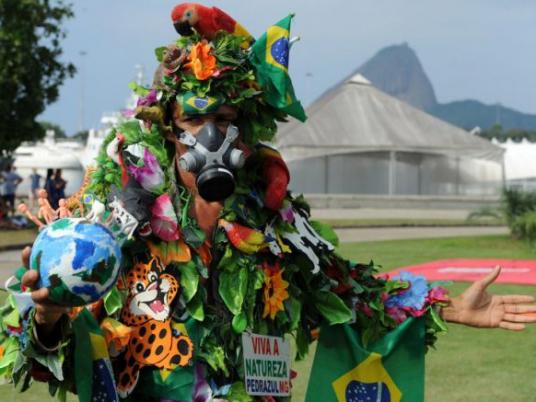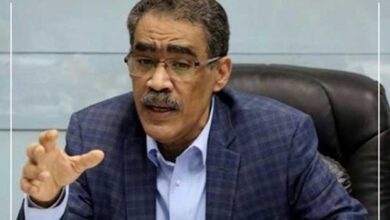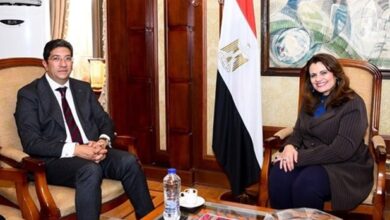
The outcome of the Rio+20 conference have been disheartening for many environmentalists. The “Future we want,” as the conference slogan purports, is proving to be a future they did not envisage.
In the opening session on Wednesday, civil society leaders were invited to advise heads of state on the conference’s draft text.
Representing NGOs and civil society, Wael Hmaidan, Director of Climate Action Network International (CAN-I) informed world leaders that “NGOs here in Rio in no way endorse the document.”
He said, instead of that civil society had drafted a document titled, “The Future We Don’t Want” that refuted the conference’s current text. He demanded that the words “in full participation with civil society” be removed from the first paragraph of the text.
Later in the day, several marches and protests were launched throughout the city by civil society against the Rio+20 Summit and the lack of ambition expressed by world leaders on tackling the globe’s biggest environment problems.
A mass rally that worked from one end of the city to the other gained thousands of protestors and was met with some resistance by police forces towards the end of the day in downtown Rio.
On Thursday afternoon, civil society youth protested inside Rio Centro in front of world leaders were seated, called the “Future we bought.” The group of youth ripped up the text to demonstrate their dissaproval of capitalist dominance of the negotiations.
Amid the environment of disapproval, it has become increasingly clear that the real players and success stories of Rio are from the sidelines of the official summit, not the corridors of power.
People’s Summit
While world leaders made opening statements at the official summit of Rio+20, civil society and NGOs from across the globe came together just across the city in Aterro de Flamengo at the People’s Summit for Social and Environmental Justice.
They offered an array of innovative grassroots solutions to sustainable development. They said they had coped with the economic and social injustices prevalent in their communities and to them, the official Rio+20 Summit in Rio Centro did not, and has never represented them.
In the 20 years since Rio 92, the United Nations environmental branch has been criticized for its lack of action to overcome social and environmental injustices. The official call of the Rio+20 Summit of “Green Economies” is seen by these groups as a re-vamped form of green capitalism echoing the capitalist models of production and consumption in a “sustainable” manner.
The counter-summit did resemble the environmental-themed Woodstock, with stereotypical tree huggers who actually hugged trees for positive energy, Hari Krishna enthusiasts holding hands and singing songs to the Earth Gods, and indigenous people holding peace signs and performing yoga and meditation sessions. But there was much more to the festive hippy-like bazaar than met the eye.
The People’s Summit had several tents with sessions to allow those who would otherwise be voiceless to be heard. Speaking there were forums for women, indigenous peoples, farmers and fisherman, and many groups that had been unable to get through the gates of Rio Centro to express their concerns to world leaders. Issues such as the dangers of nuclear power and forest preservation were highlighted with ingenuity.
Booths were powered solely by volunteers, and whole motorcycles constructed entirely out of scrap material and waste products demonstrated grassroots innovative solutions. Many exhibitions at the People’s Summit were more ingenous than solutions that were being proposed across the city in Rio Centro.
Side Events and Pavilions
Across the halls in Rio Centro, there was an array of side events varying in topics and themes. But the gathering’s immense amount of knowledge and information seemed to be lost on the negotiators once again.
Events organized by various organizations such as the UN-Women, IMF and World Bank, FAO, and C40 for Mayors of cities for urban planning and growth were among the many networks and academics present. Networking with other organizations with similar interests seemed more important to these groups than the actual negotiations.
UN-Women's events focused on women as the most vulnerable group to climate change and other natural disasters, showing that women’s issues do pertain to sustainable development. For example, in sub-Saharan Africa, it is women who travel far from home to bring well water, putting them at greater risk of being attacked in war-torn regions.
Other events organized included an entire day dedicated to water, expressing the inefficiencies in dealing with some of the world’s water-scarce regions. Water quality and pollution from fertilizers and inadequate treatment of wastewater have caused immense problems. On a global level, 2 million tons of sewage is discharged daily in drinking water sources, causing deadly water-borne diseases. Statistics from UN-Water show that 1 child every 20 seconds dies from water-borne diseases globally, which means that more people are killed from polluted water daily than from all forms of war.
The IMF and World Bank hosted a side event on carbon taxation and fossil fuel subsidies , two suggestions for economic policy reform. Panelists explained that 410 billion USD/year is spent on subsidies across the globe, but that the rich people receive 6 times more from the subsidies than the poor.
Such taxation schemes would need to be targeted towards the source of the emissions however, such as taxing the amount of fuel used rather than vehicle ownership. Taxing should also be on emissions produced, not electricity consumed.
Several solutions were proposed on the issue carbon taxation from the sidelines, but once again the negotiators did not listen.
The US, in a side event at their pavilion, suggested a city-level solution to adapt to climate change in terms of green infrastructure. The city of Philadelphia is an example of such an initiative, with its drainage design that funnels the first inch from rainfall to green spaces. The initiative increases green spaces on all pavements, rooftops and large vacant areas to retrofit their infrastructure system to adapt to the effects of climate change. Such solutions on a city level are precisely the kinds of solutions we need to learn from.
The real heroes here in Rio are not those in the negotiation rooms, but those backstage sharing their innovative solutions or climate change and sustainable development from their communities and cities.
These efforts truly demonstrate that real change can occur through real, breathing collaboration. In the words of Achim Steiner, the UNEP Secretary General, “the people of this world will refuse to be silenced by the brackets in the text”.
We may be disappointed by our world leaders’ actions at Rio+20, but let this be motivation for us as citizens to work together to make these solutions happen and let our efforts speak for themselves. Let us learn from these inspiring grassroots movements here in Rio that if we work together we can create true change for a sustainable future for our people.
Lama El Hatow is an Egyptian environmental activist representing IndyACT (a league of independent activists) in the NGOs and civil society movements at the Rio+20 Earth Summit.




